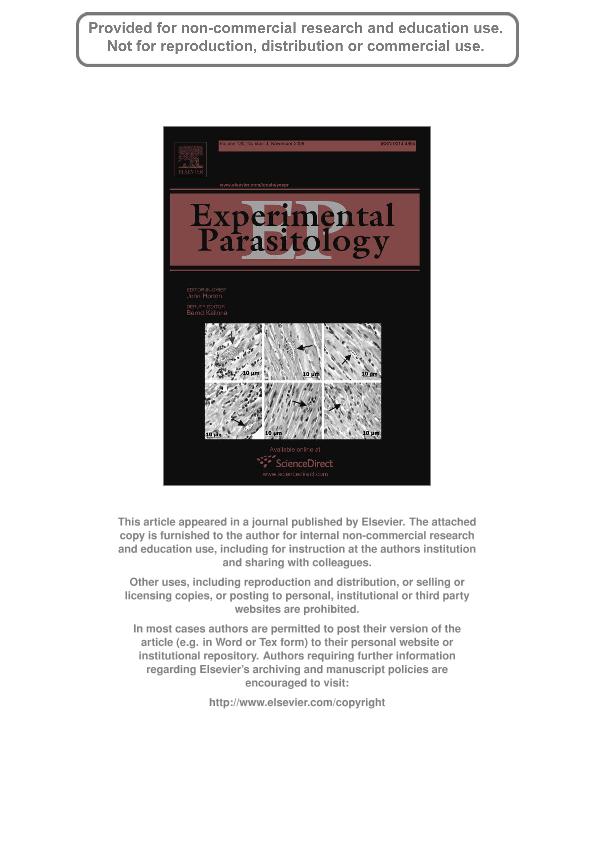Mostrar el registro sencillo del ítem
dc.contributor.author
Velázquez, Melisa María del Luján

dc.contributor.author
Diez, Cristina Noemí

dc.contributor.author
Mora, C.
dc.contributor.author
Diosque, Patricio

dc.contributor.author
Marcipar, Iván Sergio

dc.date.available
2018-02-16T13:52:50Z
dc.date.issued
2008-11
dc.identifier.citation
Velázquez, Melisa María del Luján; Diez, Cristina Noemí; Mora, C.; Diosque, Patricio; Marcipar, Iván Sergio; Trypanosoma cruzi: An analysis of the minicircle hypervariable regions diversity and its influence on strain typing; Elsevier; Experimental Parasitology; 120; 3; 11-2008; 235-241
dc.identifier.issn
0014-4894
dc.identifier.uri
http://hdl.handle.net/11336/36598
dc.description.abstract
The current intraspecific nomenclature in Trypanosoma cruzi describes two major lineages, named T. cruzi I and T. cruzi II, and five sublineages within T. cruzi II, named IIa, IIb, IIc, IId and IIe. The polymorphism of minicircle hypervariable regions (mHVRs) of T. cruzi has been used in many studies for the molecular characterization of parasite populations directly from biological samples. However, the molecular bases that allow strain typing by these markers are still unclear. In this work we examined forty cloned mHVRs sequences of CL-Brener reference strain (IIe sublineage), and we found a predominant group of sequences, with 40% of frequency in this strain, with a 97% of identity among them. Out of the forty clones analyzed, we identified other less representative types, and a few unique ones. This predominant sequence is also present in different reference strains belonging to the other main T. cruzi lineages and sublineages (TcI, IIa, IIb, IIc and IId) although in a many thousand times lower frequency than in the CL-Brener strain, as shown by semiquantitative PCR. Similarly, predominant mHVR sequences previously described for TcIId strains, were clearly more frequent (many thousand times higher) in the IId reference strain analyzed by us (Mncl2) than within the reference strains belonging to the other lineages and sublineages. The analysis of the cloned sequences shows that more sequences than just the major one contribute to define the global pattern of mHVRs RFLP in the CL-Brener strain. The possible usefulness of these predominant sequences for typing TcIId and TcIIe sublineages by semiquantitative PCR, as well as the possible role of these sequences in genotype identification by mHVR probes are discussed.
dc.format
application/pdf
dc.language.iso
eng
dc.publisher
Elsevier

dc.rights
info:eu-repo/semantics/openAccess
dc.rights.uri
https://creativecommons.org/licenses/by-nc-sa/2.5/ar/
dc.subject
Deoxynucleotide Triphosphate
dc.subject
Dntp
dc.subject
Kdna
dc.subject
Kinetoplastid Dideoxy Nucleotide Acid
dc.subject
Lineage
dc.subject
Low Stringency Single Specific Primer Polymerase Chain Reaction
dc.subject
Lssp-Pcr
dc.subject
Mhvr
dc.subject
Minicircle
dc.subject
Minicircle Hypervariable Regions
dc.subject
Pcr
dc.subject
Polimerase Chain Reaction
dc.subject
Randomly Amplified Polymorphic Dna
dc.subject
Rapd
dc.subject
Restriction Fragment Length Polymorphism
dc.subject
Rflp
dc.subject
Strain
dc.subject
Trypanosoma Cruzi
dc.subject
Typing
dc.subject.classification
Otras Ciencias Biológicas

dc.subject.classification
Ciencias Biológicas

dc.subject.classification
CIENCIAS NATURALES Y EXACTAS

dc.title
Trypanosoma cruzi: An analysis of the minicircle hypervariable regions diversity and its influence on strain typing
dc.type
info:eu-repo/semantics/article
dc.type
info:ar-repo/semantics/artículo
dc.type
info:eu-repo/semantics/publishedVersion
dc.date.updated
2017-11-03T19:09:21Z
dc.journal.volume
120
dc.journal.number
3
dc.journal.pagination
235-241
dc.journal.pais
Estados Unidos

dc.journal.ciudad
Nueva York
dc.description.fil
Fil: Velázquez, Melisa María del Luján. Consejo Nacional de Investigaciones Científicas y Técnicas; Argentina. Universidad Nacional del Litoral; Argentina
dc.description.fil
Fil: Diez, Cristina Noemí. Universidad Nacional del Litoral; Argentina
dc.description.fil
Fil: Mora, C.. Universidad Nacional del Litoral; Argentina
dc.description.fil
Fil: Diosque, Patricio. Universidad Nacional de Salta; Argentina. Consejo Nacional de Investigaciones Científicas y Técnicas. Centro Científico Tecnológico Conicet - Salta. Instituto de Patología Experimental. Universidad Nacional de Salta. Facultad de Ciencias de la Salud. Instituto de Patología Experimental; Argentina
dc.description.fil
Fil: Marcipar, Iván Sergio. Universidad Nacional del Litoral; Argentina. Consejo Nacional de Investigaciones Científicas y Técnicas; Argentina
dc.journal.title
Experimental Parasitology

dc.relation.alternativeid
info:eu-repo/semantics/altIdentifier/doi/http://dx.doi.org/10.1016/j.exppara.2008.07.016
dc.relation.alternativeid
info:eu-repo/semantics/altIdentifier/url/https://www.sciencedirect.com/science/article/pii/S001448940800194X
Archivos asociados
